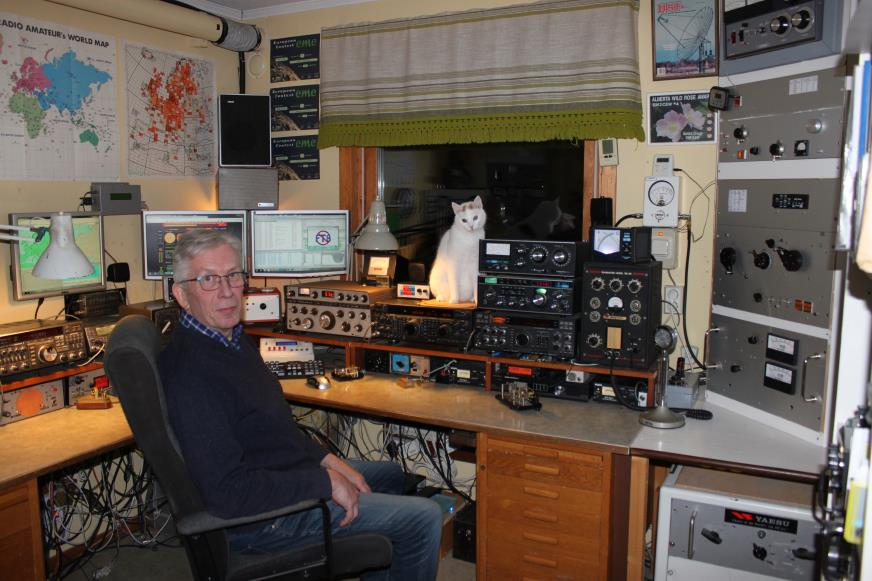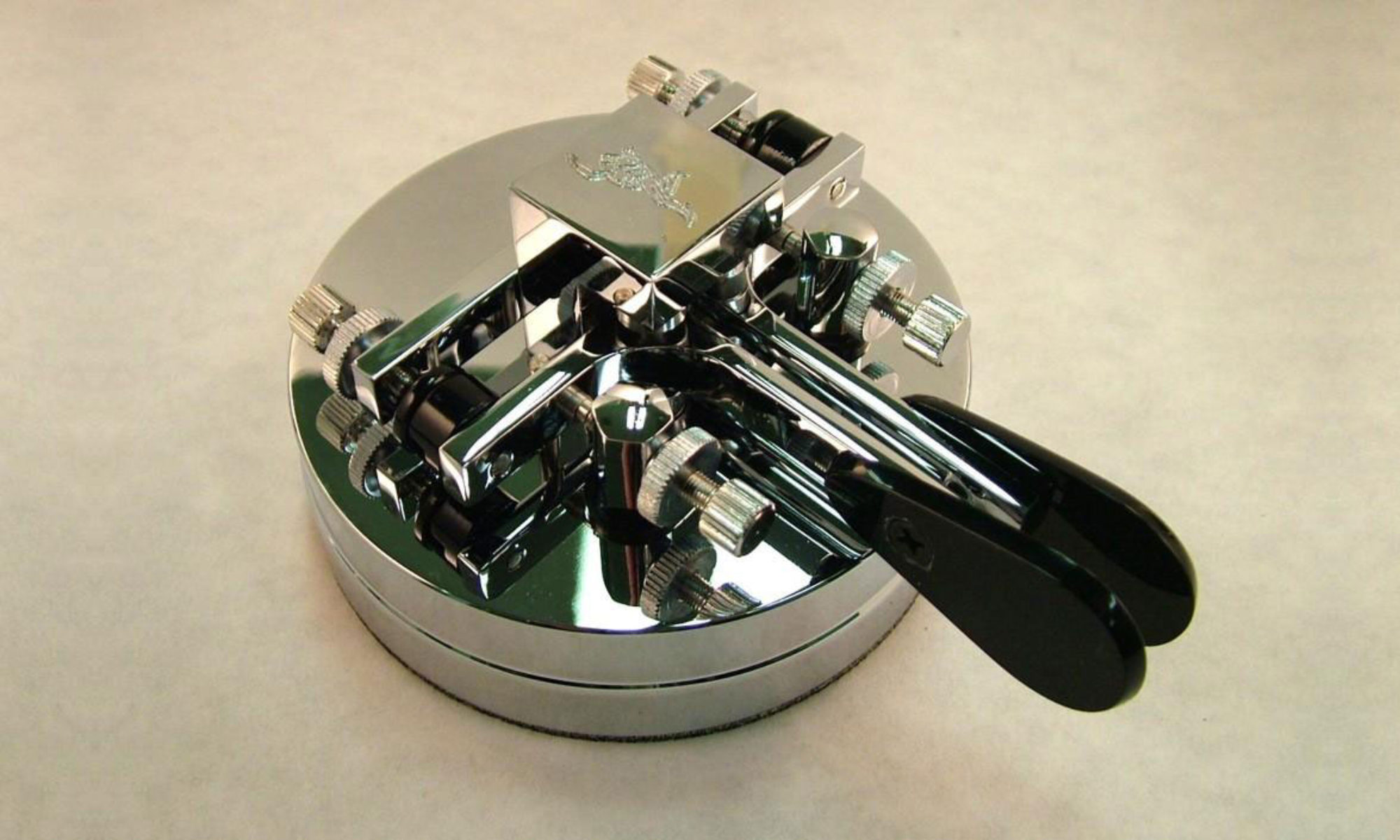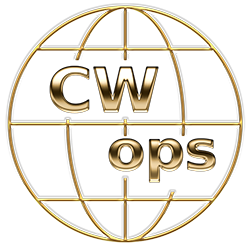
I live in a small village north of the city of Lulea in Sweden. Lulea is located at latitude 65.4N so I live just a few miles south of the Arctic Circle. But as far as radio propagation is concerned, I am well within the Polar Cap with all that follows regarding propagation disturbances.
I retired two years ago after 40+ years with the Swedish Police where I’ve upheld a number of different positions and leading ranks.
At all times since I became licensed in 1971 I have done my best to follow the radio amateurs code of ethics and suggested operating procedures. Even though, or maybe I should say because, pretty much of the detailed regulation regarding amateur radio is now gone, I find it important that we uphold high standards and strong ethics in our hobby. If we don’t, our status as highly skilled radio operators and technicians will diminish and eventually fade out completely. Such a scenario would indeed drain the hobby of all special legislation and rules that now give us a unique status compared to other users of the radio spectrum.
In my opinion CW is the most valuable core of amateur radio. And I would say, that with very few exceptions, learning how to master CW well is an excellent way to become a really good and dedicated ham radio operator. All of this might just sound like a lot of fine words from me, but I think you understand by now how my love for CW and good operating habits is rooted in me. All this since deciding to become a “ham” – a radio amateur.
It all started in 1969 when I visited a colleague of my father who was a ham (SM2BPE) and for the first time saw his station, an HRO 7 receiver and a Harvey & Wells TBS-50 transmitter.
Seeing him communicating, using a Vibroplex CW key, with a ham on the other side of the Atlantic Ocean, while at the same time translating CW to spoken words for me, had me flabbergasted. I decided then and there that I was going to learn CW and become a ham myself. This is my thing!
My father bought me a surplus BC-312 receiver for Christmas that year. And as it turned out, our national society was just starting up a new ham recruitment project by transmitting CW classes on 80m and 40m on weekends. So, I spent many months trying to learn CW via the airwaves, fighting QRM, QRN and bad propagation on the crowded bands. Remember the QRM on 40m in those days?
CW filters were non-existent in the BC-312 so I had to use the filter in my ears instead. I actually think that this has been helpful to me all along my ham career. Many times I find myself listening to CW in wide bandwidth rather than through a very narrow filter when digging out marginal signals from the noise.
A bunch of hams at our local radio club were also helpful and introduced CW classes so I eventually passed the novice class exam and became SM2CEW in June 1971. Operating at first was restricted to CW, XTAL control and maximum 10w input.
I had a ball, made new friends every day on the bands and I must admit that I skipped school now and then just to play radio. A bit later I passed the mid class exam, allowing me to use a VFO and 75w input, still no phone on the HF bands. My CW proficiency increased dramatically as I was now able to look up stations and call them on their own frequency. The increased power also helped. More stations in the log and my CW speed increased exponentially.
Passing the highest-class exam in 1974 was no problem. Now allowing me to operate on all bands, all modes with a maximum for 500w DC input power. At the time, Swedish license classes were restricted by minimum age, therefore I could not take the exam for the highest class until I was 18 years old.
I started to enter contest regularly from the very beginning in 1971 and got hooked. Contesting has been a major interest throughout my whole ham career, entering both as single op and from various club stations as part of a multi op operations.
In my opinion, the very best years in contesting were all prior to the development and availability of DX clusters. I won’t mention any calls here, but there are a lot of contest operators out there that I admire for their skills. Many of them were regularly among the top 10 in the listings, whichever contest they entered. Some of them are still active and I now find them in CWTs on Wednesdays! Impressive.
For a couple of years during the mid-70’s I had the best possible mentor and CW proficiency tutor in Bob W9KNI. At the time Bob lived in Chicago and we had regular very high-speed CW QSOs just as Bob came home from work in the afternoon. Bob was already then a fantastic CW operator and was “secretly” developing his Bencher paddle, a concept he tried to explain to me over the air but I never quite grasped how it worked and what it looked like. Until I finally saw some pictures when it was advertised. If I remember correctly, the Curtis one chip CW keyer was also part of Bobs developing work at the time.
Bob is, as we all know, the perfect DXer! During this period, I was fortunate enough to learn so many things on how to steadily build up my DXCC count. I listened and learned from Bob and his experiences, and still to this day make use of what he told me. And his advice was not just limited on how to work DX, it was also about how to behave on the ham bands to earn respect and to be a good colleague. I am ever so thankful for this.
Jumping forward some 40+ years I am still active daily on CW. The first thing I do in the morning is to turn on my radios. And the last thing I do at night is turn them off to get some hours of sleep. CW takes me all around the globe, on any band from 1.8 MHz to 10 GHz.
From 144 MHz and up I bounce signals off the moon surface to work CW DX. My antennas for this are rather big by comparison. I have even made a rather unique CW moonbounce QSO on 28 MHz using my stacked Yagis looking at the moon on the horizon.
On HF a multitude of antennas help me work DX. Now that the high bands, where I use stacked Yagis, are closed due to lack of sunspots, my verticals for 160/80/40m allows me to make use of a more quiet ionosphere to enjoy great propagation on the low bands. At times even the polar path opens up on 160m to the western part of North America and to the Pacific.
But I don’t limit myself to operating from home with high power and big antennas. Operating /portable with low power and a wire antenna is equally fun. Every contact that goes into the logbook under such conditions feels like a big achievement to me. I even do contesting this way, especially during the Scandinavian Field Day contest in spring and fall.
More info about myself and my station can be found on my webpage
There are also sound files on the website that might give you an insight to what Top Band sounds like when conditions are really good up here. CW at it’s best.
To wrap it up, a good friend of mine, Jim SM2EKM, used to preach that we all need to call CQ more. We all can’t just listen all the time as we cannot hear each other’s receivers to find out who is out there. I think this is a very good suggestion and I try to follow Jim’s advice every day. On a band of preference depending on conditions and what my target is. And believe me, it works!
Many thanks to Lar K7SV for nominating me and to the people sponsoring me for membership in the CWops group. I am now proud a member #2385.
Robert Krasowski NW2Z
First, I would like to thank Mike K4GMH, for nominating me, Joe N3HEE, who was my CW Academy instructor, and all of you that QSO with me. I know you had to suffer with my horrible code, incorrect spacing, changing speed, and spelling mistakes. Thanks to all of you, I became a member of CWOps.
I am Polish, I grew up in a Communist country with a lot of restrictions. Since I can remember I was fascinated by radios. I remember my grandfather sitting in front of the old vacuum tube receiver and listening to Free Europe Radio. It seemed incredible to me that you can hear people from the other side of the Iron Curtain. When I was 11, I joined a local ham radio club. We did not have much equipment to work with then. We only had an old military radio, RBM1, only 1 watt and AM. My mentor at that time was a physics professor Ryszard SP4CJA. Eventually I purchased an old WWII receiver from a Russian tank (RS20). I spent hours listening to it. I discovered that people from the “other side” were nice and not monsters like they were pictured in the Communistic propaganda. In December of 1981, the Polish Government introduced Martial Law. As a consequence, my receiver was confiscated by the police. I have never seen it again. It was very difficult to get a ham radio license in Poland. In 1990 I came to the USA. Very quickly I realised that becoming a licensed ham radio operator was much easier here. Within a year I became KB2PNM with a Novice class license. I can say that my CW adventure started here, but this is not exactly true. I learned 5 wpm from Gordon West book and tapes. Now, I know that this was the wrong way to learn CW. Two years later I upgraded to a General Class License. That required 13 wpm. I miraculously passed, and it was more pure luck than skill. I did not like CW. I did maybe 5 QSOs on that mode sweating and suffering. It simply was not my “thing”.
I have been an active ham radio operator for all these years. You could find me on SSB, all digital modes. I ran Pactor mailbox, PSK Mail server, I experimented with WSPR (I did tracking with Ultimate 3s transmitter while sailing from Tonga to Fiji), and I’ve worked a few satellites. My “speciality” was communicating with and helping sailors. I’ve helped close to 100 sailors over a period of 30 years. But still, no Morse code.
About 1.5 years ago, I went to our ham radio club meeting. We met in LNR Precision shop. I saw a Mountain Topper that was produced there, and something clicked. I realized that I can go on my sailing trips with a small radio that can fit in my pocket. However, there was one obstacle. Mountain Topper has only CW mode. Therefore, I started to practice. It is much easier now since there is a lot of software available on iPhones and computers. I quickly relearned all the characters and became quite proficient with paper copy. I was able to manage up to 20 WPM. I became a SKCC club member, my member being 15533, and I was doing “standard” QSO on the SKCC part of the band. However, I wasn’t satisfied. Sometimes I tuned into the CWOps side of the band and I was amazed at how people can do that. I realized that the only way to improve my speed was to do head copy. What a shock. When I stopped using the pencil and paper, I couldn’t copy anything. I was able to catch some words at 8 WPM. At that time I had already signed up for the CW Academy level II. I waited a few months and in September I joined a group of four hams like me who wanted to improve the speed of their code. Joe, N3HEE, became my instructor and I admire him for his patience and incredible ability of copying my code with my many, many mistakes and spelling errors.
I enjoyed the Academy tremendously. It is free, but I joke that it was very expensive to me. I purchased a Begali HST (great key), Flex 6600 and KPA 1500. When my wife asked me how much all of it cost, I told her a thousand (I left “s” at the end of the word silent so please do not tell her). CW Academy was the best thing I did for my CW. It built up my confidence and showed me that it was possible to copy in my head. Since that time, I do at least one QSO a day on CW. I met John, K3WWP, who became an inspiration for me. So, now I do QSO daily. Every Thursday I talk to Mike, K4GMH. His code is as perfect as it can get. I am not much of a contest guy, but I did a few CWTs and I’m ready to do more. You can hear me on 80 or 40 every day, but please be aware, when you call me, it is not going to be 599 Robert NC, we will rag chew.
I am a cardiologist by profession, so my life is very busy. CW allows me to relax from my sometimes stressful work life. Also, meeting all of you is fascinating.
Thank you to all of you that helped me become the member of CWOps. I’m looking forward to many more QSOs, so see you on the air!
This biography is what appeared in Solid Copy when the member joined CWops.
